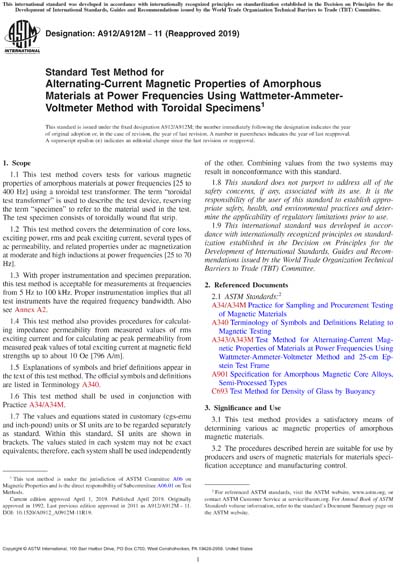Most recent
ASTM A912/A912M-11(2019)
Standard Test Method for Alternating-Current Magnetic Properties of Amorphous Materials at Power Frequencies Using Wattmeter-Ammeter-Voltmeter Method with Toroidal Specimens
1.1 This test method covers tests for various magnetic properties of amorphous materials at power frequencies [25 to 400 Hz] using a toroidal test transformer. The term “toroidal test transformer” is used to describe the test device, reserving the term “specimen” to refer to the material used in the test. The test specimen consists of toroidally wound flat strip.
1.2 This test method covers the determination of core loss, exciting power, rms and peak exciting current, several types of ac permeability, and related properties under ac magnetization at moderate and high inductions at power frequencies [25 to 70 Hz].
1.3 With proper instrumentation and specimen preparation, this test method is acceptable for measurements at frequencies from 5 Hz to 100 kHz. Proper instrumentation implies that all test instruments have the required frequency bandwidth. Also see Annex A2.
1.4 This test method also provides procedures for calculating impedance permeability from measured values of rms exciting current and for calculating ac peak permeability from measured peak values of total exciting current at magnetic field strengths up to about 10 Oe [796 A/m].
1.5 Explanations of symbols and brief definitions appear in the text of this test method. The official symbols and definitions are listed in Terminology A340.
1.6 This test method shall be used in conjunction with Practice A34/A34M.
1.7 The values and equations stated in customary (cgs-emu and inch-pound) units or SI units are to be regarded separately as standard. Within this standard, SI units are shown in brackets. The values stated in each system may not be exact equivalents; therefore, each system shall be used independently of the other. Combining values from the two systems may result in nonconformance with this standard.
1.8 This standard does not purport to address all of the safety concerns, if any, associated with its use. It is the responsibility of the user of this standard to establish appropriate safety, health, and environmental practices and determine the applicability of regulatory limitations prior to use.
1.9 This international standard was developed in accordance with internationally recognized principles on standardization established in the Decision on Principles for the Development of International Standards, Guides and Recommendations issued by the World Trade Organization Technical Barriers to Trade (TBT) Committee.
Content Provider
ASTM International [astm]






